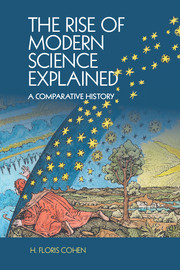Book contents
- Frontmatter
- Contents
- Introduction: the Old World and the New
- 1 To begin at the beginning: nature-knowledge in Greece and China
- 2 Islamic civilisation and medieval and Renaissance Europe
- 3 Three revolutionary transformations
- 4 A crisis surmounted
- 5 Expansion, threefold
- 6 Revolutionary transformation continued
- Epilogue: a look back and a look ahead
- Timeline 1: pre-1600
- Timeline 2: 1600–1700
- A note on the literature
- Provenance of quoted passages
- Index
5 - Expansion, threefold
Published online by Cambridge University Press: 05 March 2016
- Frontmatter
- Contents
- Introduction: the Old World and the New
- 1 To begin at the beginning: nature-knowledge in Greece and China
- 2 Islamic civilisation and medieval and Renaissance Europe
- 3 Three revolutionary transformations
- 4 A crisis surmounted
- 5 Expansion, threefold
- 6 Revolutionary transformation continued
- Epilogue: a look back and a look ahead
- Timeline 1: pre-1600
- Timeline 2: 1600–1700
- A note on the literature
- Provenance of quoted passages
- Index
Summary
Kepler and Galileo, Beeckman and Descartes, Bacon, Gilbert, Harvey and van Helmont were each in their own way pioneers who, with their revolutionary transformations around 1600, were far in advance of the foot soldiers they had left behind. Even if we leave out of further consideration the profound ideological problems attached to their work, one would still have expected the three prevailing modes of nature-knowledge to survive for some time as if nothing much had happened in the intervening period. The surprising thing is that when you look back from around 1700 you find how little remained of these ‘old’ modes of nature-knowledge. In the first half of the seventeenth century there were still many who practised mathematical nature-knowledge in the old, hyper-abstract manner of Archimedes, of Euclid and of Ptolemy's Almagest. This was particularly true of planetary theory and the study of light and vision. When, between 1600 and 1625, Harriot, Snel and Descartes each discovered the law of refraction first found by Ibn Sahl, it still fitted almost seamlessly within the tradition. And in so far as a generation of astronomers after Kepler could approve of his results at all, they were as a rule still handled in tried and trusted fashion as fictional aids to model building of the usual kind. By the end of the century, this has all been swept away and ‘Alexandria-plus’ is the order of the day. This involves what I have called Ptolemy's bridge building as well. Ptolemy had ingeniously sought to inject elements of the real world in current, highly abstract mathematical accounts of the propagation of light (updated in the eleventh century by Ibn al-Haytham), of musical consonance (updated in the sixteenth century by Zarlino) and of planetary trajectories. As realist-mathematical science expands beyond Kepler and Galileo, all this begins to be replaced with almost brand-new physical theories in the former two cases, concurrent with the speedy demise (at least among astronomers) of belief in horoscopes or in any planetary influences at all. When in December 1659 Huygens is invited by a daughter of the late stadhouder (whom his father had served as secretary) to inspect her nativity and cast her horoscope, he knows that he cannot refuse, but he asks his fellow astronomer Boulliau to do it for him.
Information
- Type
- Chapter
- Information
- The Rise of Modern Science ExplainedA Comparative History, pp. 183 - 217Publisher: Cambridge University PressPrint publication year: 2015
